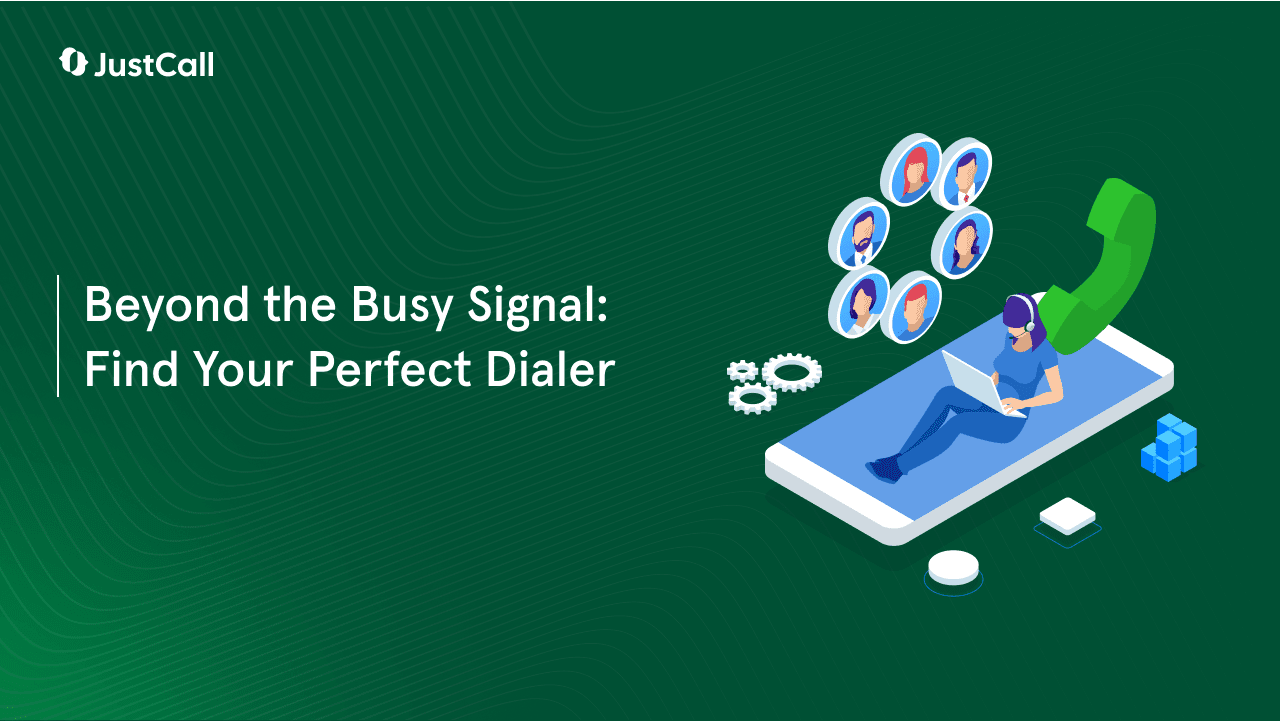Predictive and auto dialers are two different variants of sales dialer software.
Predictive dialers make multiple calls together and intelligently ‘predict’ agent availability for the next call. Auto dialers, on the other hand, dial numbers one by one in sequence.
That’s the broad difference. But take a closer look, and you see the unique advantages of each of these dialer types.
How a predictive dialer works
A predictive dialer calls multiple numbers together, connects live calls to a team of reps, and then automatically delivers the next call when a rep becomes available.
The goal is to reach as many contacts as possible with minimal manual input. Here’s how this is achieved.
- When you feed a predictive dialer a list of leads to call, the software dials multiple numbers together. It has an answering machine detector built-in, so all calls that go to machines or busy tones are accurately skipped.
- Then, calls picked up by actual people (‘live calls’) are automatically routed to multiple reps together. Whoever’s assigned a call then jumps into a conversation.
- Here’s the neat bit: while the team is on different calls, the predictive dialer’s brilliant algorithm has already figured out when a rep will be available for the next call. It then dials the next number and keeps it ready to assign.
- If a rep takes a couple of seconds extra to join the next call, the predictive dialer keeps the recipient engaged with an automated voice recording till the agent can start talking to the customer.
How does the algorithm work?
The short answer: complex math.
The long answer: the algorithm estimates agent availability by factoring in data across parameters. These include the number of reps available for calls, average talk time, the number of calls it takes to get a human to pick up, the success of previous campaigns, etc.
This statistical computing means not a second is wasted between calls, and reps reach more leads with every dial.
How an auto dialer works
An auto dialer dials one number at a time and assigns a call as soon as it’s picked up.
The goal is to reach more leads faster while also giving salespersons as much time as they need to personalize conversations. How this is achieved depends on the type of auto dialer being used.
Types of auto dialers
There are two major types of auto dialers: power dialers and preview dialers.
Calling campaigns with either type start the same way: numbers are automatically dialed by sequence, busy tones are skipped, and live calls are assigned to reps.
Where the two auto dialer types differ is in what happens once a call is done.
- Preview dialer: Needs the salesperson’s input to dial or skip the next number. Typically used when sales reps need time to review contact details before getting onto a call. The dialer automatically pulls these details from the CRM.
- Power dialer: Automatically moves on to the next number in the list. No manual input required. Typically used when the sales pitch is largely the same for each contact and personalization isn’t vital.
Which dialer is right for you?
The choice between predictive dialer vs auto dialer comes down to your sales requirement: getting through long cold calling lists faster, or scaling up personalized conversations for warm/qualified leads.
Predictive dialer for volume
If you frequently run high volume cold calling campaigns (like in a contact center), it makes sense to invest in a predictive dialer. To understand why, let’s do some math.
Say you have a team of 10 sales reps. You’ve given the team a modest target of 20 conversions for one day. That’s 2 conversions per rep in a day. Not too hard.
Without a predictive dialer
Assuming the average cold call success rate of 0.3%, your team needs to make 6600 calls to achieve their target (or 660 calls per rep in a day) of 20 conversions.
Now, assuming it takes 1 minute for a rep to manually dial a number, that’s about 11 hours of non-stop dialing.
On average, about 70 to 80% of cold calls go unanswered. So you’re looking at at most 30% of these calls turning into a pitching opportunity. In our example, that’s 200 calls per rep.
If a call is picked up, let’s say it takes 1 minute for the rep to pitch. That’s a little over 3 hours of talk time for 200 calls, and the number goes up if a prospect wants to learn more.
So, to drive 2 conversions in a day, a rep needs to spend 11 hours dialing numbers and an additional 3 hours talking and delivering pitches. That’s 14 hours, at minimum.
With a predictive dialer
With a predictive dialer, the number of calls made per dial is at least 4x. Each dial takes a minute. So, for a team of 10, that’s 40 calls a minute.
Since the predictive dialer will skip calls not answered by a person (that’s 70% of calls), about 10-12 calls will be assigned to reps with every dial.
We assumed each rep takes a minute to deliver a pitch, so the whole team delivers at least 10 pitches in a single minute.
Now, the team needs to get through 6600 calls. So, if getting through 40 calls takes 1 minute, getting through 6600 calls will take about 3 hours.
The difference is significant
In the case we took above, it took the sales team 5x more time to hit their daily target with manual dialing than they would with a predictive dialer — and that’s assuming each rep has had multiple cans of Red Bull and dials with no breaks or burnout.
To manually reach the scale of a predictive dialer, you’d have to 4x your team. This means spending on hiring, training, and salaries for a much larger team.
So not only is a predictive dialer (far) more efficient than manual dialing, it’s also saving you money.
Not to mention with features like on-screen scripts, voicemail drop, CRM integration, workflow automation, local presence dialing, custom caller IDs, etc., your reps sell with a lot more confidence, save time on admin tasks, and see better answer rates.
Auto dialer for precision
If you frequently target sales qualified leads (SQLs) who are likely to pick up your calls, an auto dialer is the right fit.
It’s perfect for inside sales teams with about 2-3 reps, or larger outbound teams targeting a small set of qualified leads in a specific campaign.
Why not a predictive dialer?
The whole point of a predictive dialer is to get through hundreds of cold leads as fast as possible. This means a sizable team quickly delivering pitches before a prospect hangs up. That’s not what an auto dialer is built for.
An auto dialer takes a more deliberate but scalable approach to calling.
Leads targeted typically have some context of who you are and why you’re calling, so they’re likely to respond and engage with you. The number of leads is also smaller, so the sales team required is proportional.
The goal of an auto dialer is to engage in as many precise, meaningful conversations as possible per hour. This means the average call can last anywhere between 5 and 20 minutes (or more if you’re in B2B).
A predictive dialer will be severely underutilized for such focused sales approaches.
It doesn’t have to be a choice
Some excellent dialer products come with both predictive and auto dialing modes. All you have to do is choose which dialing mode will be best for a particular campaign. In other words, the predictive dialer vs. auto dialer question becomes redundant.
The advantage of combined dialing modes is sheer flexibility. Need to power through hundreds of leads quickly? Predictive dialer. Targeting a small set of warm leads and need a more focused, precise approach? Auto dialer.
JustCall’s Sales Dialer comes with auto and predictive dialing modes, plus a dynamic dialing mode for time-sensitive calling campaigns. Try it for free for a couple of weeks, and see if it’s what your team needs.












